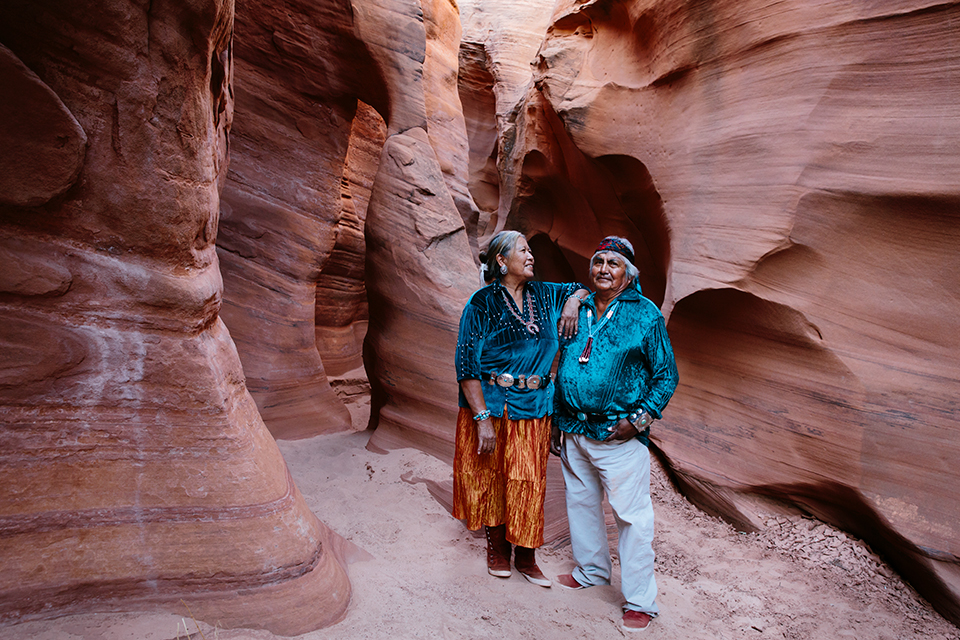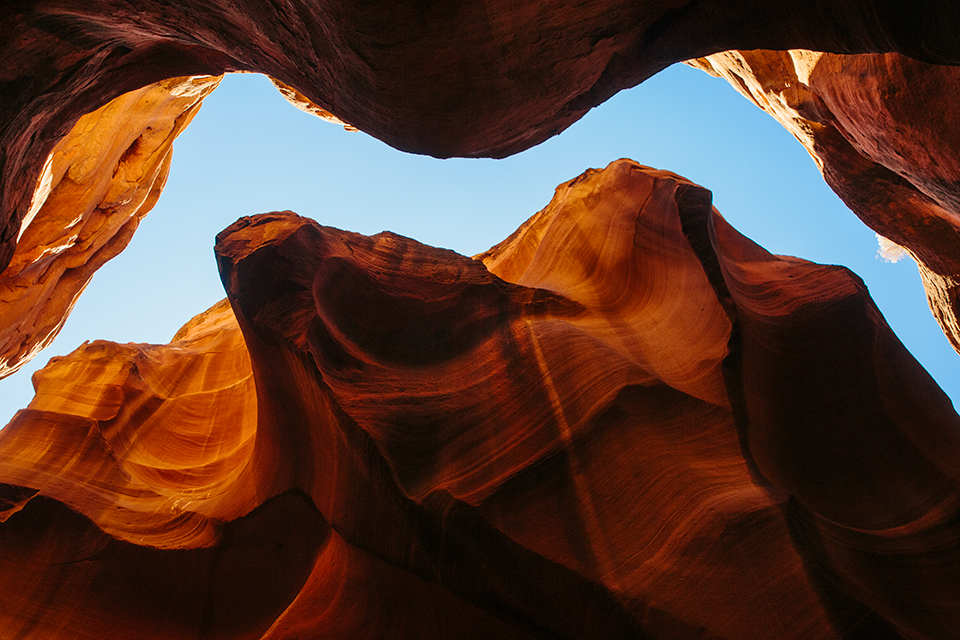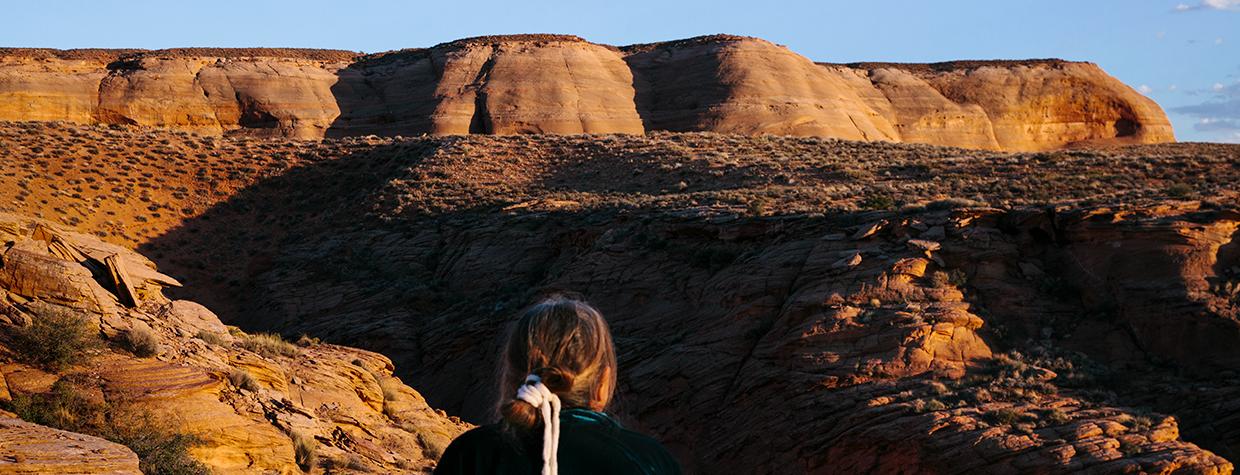It felt longer than it was, the canyon.
The way it curved and climbed and dropped again. The shadows. The light. The sky. Out of and under and through the present, into the past and back again.
Mystical Antelope Canyon runs from east to west — or west to east, depending on how you approach it — for roughly a half-mile. The slot canyon is like its counterparts, Upper and Lower Antelope Canyon, in that it is cut into the tawny earth of the Navajo Nation, the more than 27,000-square-mile blanket of land that crosses Arizona’s northeastern corner into Utah and New Mexico. It is dissimilar in that the others are oriented from north to south, or south to north — up and down, instead of sideways. This canyon receives the famous light beam year-round.
This is a distinction in which Lester Littleman takes pride.
“Nature put its mark here,” he says, looking out over the space where the canyon appears as a buckle in the Earth’s crust. “The East is a door to life, to the four sacred mountains. We are a holy people, and we provide and pray for Earth.”
Lester’s family has lived on and worked this land, between Page and LeChee, for generations. He had long heard stories about the canyon, which his elders discovered while they were running livestock across the scrubby terrain, but only recently investigated it.
“We talked about it for 10 years,” he says. “Finally, I told my grandson to go check it out.”
So he did. And he found 20- to 30-foot drops and a sort of reverential silence — a space that commanded respect.

Here on the Navajo Nation, I am an Anglo woman, interpreting stories from a culture of which I am a student, but not a part. Lester stands on the edge of the canyon and tells me that his people, The People, Diné, believe that spirits live atop cliffs. This is where the wind lives, too. Some wicked spirits will throw people from high places. Sometimes, it’s best to stay away, he says.
The way the words fall from his lips gives me that dry, electric feeling on my skin and in my teeth, the kind that starts like a shock, then moves like a current through the spaces between my bones.
I think about the way stories are handed down. I think about tradition.
My sister, Jenny, recently traced my family’s ancestry. On my father’s side, our own elders were found in pockets of the South — in what are now the states of Tennessee, Mississippi and Virginia — in the 1730s. One man, our great-great-great-grandfather, was a Confederate prisoner of war. He lost his leg. And his pension eligibility.
There is a part of me that wishes I didn’t know this story, the one with the occasional peppering of bad spirits. Elsewhere in my logic, I find a sort of security in all of the distance between the Confederate soldier — James Byrd Francis — and my children and me.
On my mother’s side, though, our people were from Galicia, a strangely shaped pocket of land that straddled what now are the countries of Ukraine and Poland. My great-grandparents, Thomas and Anna Chrustawka, moved to the United States during the Russian Revolution. He worked for the Ford Motor Co. in Detroit. She died when my grandmother was very young.
But when I was very young, my grandmother would make pedaheh (in Ukrainian), or pierogi (in Polish). Only recipes have transferred between the generations of my family. So far, there have been no canyons, no ancient language to try to protect.
But the Littlemans — Lester; his wife, Roseann; and his daughter, Celesta — have brought me to their land so they can speak about inheritance, about spirits, about the Earth and our relationship to it.
As we enter the cool cradle of the canyon, a cloud moves overhead. There are hushed conversations about rain, but Roseann is certain it will stay away. The same tingling between my bones tells me she’s right.
Mystical Antelope Canyon was formed as all slot canyons are. By time and water, the slow carving of stone by temporary rivers. If you are lucky, Roseann will demonstrate the science of it for you, her small hands building a mound of red sand, digging a drainage, pouring from her bottle to show the way the water moves through. She will speak to Lester in their language as she works through thousands of years in a minute and a half.

The wind whistles through the canyon.
“Nature creates itself,” Roseann says. She is speaking to me in English again, but I am seconds delayed, back in the hushed rhythm of the Diné.
Halfway through, we understand how the canyon was named. Up, 20 or 30 feet above us, the walls inch closer together, forming an “M” with sky pouring through. It is a jagged smile. A fracture in the dome of this ancient cathedral.
“ ‘M.’ Mystical. Mystical Antelope Canyon,” Lester says.
We are careful to not step through an oblong hole in the wall near where we will walk out of the canyon, despite how it pulls us near to it. There is a current here, a waterless tide moving inside the walls.
“It’s a passage to another dimension,” Lester warns. “If you go, it’s important to walk back through in exactly the same way.”
There is the mysticism again — the dry, electric current in the spaces between bones.
We talk about sacred plants as we leave the canyon. The air is warmer on the outside, and the light is dappled, caught somewhere between sun and cloud.
Guests will stay on the Littlemans’ property tonight, in traditional dwellings the family has built. There may be wagon tours, stargazing, stories. Camping is available here, too, in pretty, shaded spots.
It’s all part of the experience the Littlemans are hoping to create as they begin to offer private tours of the canyon.
“We knew that we wanted to do this privately,” Roseann says. “I know it’s unbelievable that we didn’t let the big secret out, but we thought, Well, that’s why we call it mystical. It’s nature’s force, and we want to leave it that way. But there’s also a lot of learning and history. Nature put its mark here. The canyon will teach us.”
I am an Anglo woman, interpreting stories from a culture of which I am a student, but not a part. Still, the current has settled into the spaces between my bones. And as the light fades on the Littlemans’ land, the wind whistles another song.

